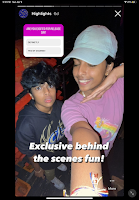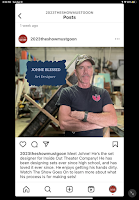The docuseries, The Show Must Go On, focuses on teaching its viewers about how much effort goes into creating a theater process, in all its different aspects. For this portfolio project, I focused on the second episode, which focuses on the technical aspect of putting up a production. I communicated this message by including a variety of interviewees with various thoughts of the tech process, and including b-roll shots of them doing this process.
My project represents a variety of social groups and issues. For my interviewees, there are a variety of different genders, ages, and backgrounds. For instance, there are three girls, the two Andreas and Nicole.
[Fav girls!]
There are also two boys, Johne and Santi.
[Fav guys!]
There is also a variety of ages because Andrea Chiquito and Johne are both grown adults, while the other three interviewees are teenagers in high school. Andrea Chiquito is in her 20s and Johne is in her 60s. This also adds to the different backgrounds and experiences that my interviewees have. Johne is the one with the most experience, since he has been constructing sets ever since he dropped out of high school in 1979. He is also very passionate about his craft, and is even motivated enough to work completely by himself. Even though Andrea Chiquito is older than the teenagers, she just started teaching shows a few years ago. However her background is different because she is much more mature than the teenagers, and has a lot of experience in the theater business in general. Nicole and Andrea Hernandez have about the same amount of experience in teching shows since they have both been doing it for about two years. However the difference between them is that Nicole absolutely loves doing it and does it because it is her passion, but Andrea Hernandez mainly does it for the service hours. Santi is completely different than all four of these people because he was dragged into teaching since he is friends with Nicole. When asked if he would tech a show again, he said no because he does not enjoy doing it. I think interviewing people with such different social groups really adds perspective to my documentary, because it shows teh different sides of how a show goes on. For instance, even though Santi absolutely hated teching, he still stayed and tried his best to help, since he knew that the show needed to happen some way or another. It also focuses on the main issue of whether or not the tech crew gets enough appreciation from the audience, and why they continue even though there are so many struggles. The general issue discussed is why people continue to pursue things even though people don’t usually understand how much effort goes into doing something. The issue here is mainly that people usually don’t understand what it’s like to do things that require so much hard work, since they’ve never done something like that before. However this docuseries aims to solve this issue by showing people the struggles and why they should’ve be more appreciative.
The elements of my production works together to create a sense of branding by using the social media, magazine, and docuseries in cohesion with each other. Especially in the social media aspect, I really wanted to sell my docuseries as something that would be a fun enjoyable watch, that would also be seen as a learning experience to learn about appreciating the art of theater. Through the branding, I did certain things in order to share this message. For instance, in both the magazine and social media, I tried to use bright colors (specifically red and blue to match the theme) in order to be more fun.
[Red and Blue theme]
Also for the social media, I tried to make it fun and engaging by doing interactive and funny story posts. I even included a bloopers reel to make it even more funny and real. For the actual docuseries extract, I included serious moments when the interviewees genuinely talked about their struggles. But I also decided to include some funny aspects to the extract, so that it would fit with the fun and entertaining branding of a Netflix show.
My product engages with the audience, specifically with the social media element. This is because it has many stories that directly engage with the audience. For instance there are many question box stories, that ask the viewers questions that they have about specific things. This means that they are directly interacting with me, the creator of the docuseries.
[One example of a question box post]
There are also less direct ways of interacting with the audience, by just making interesting graphics to look at. All of my posts on the instagram are not bare, and they actually have an artistic element in them to make them more visually engaging. For instance, I could have done a plain picture for the interviewee post introductions. However, I made the choice to draw on these posts to showcase them in a more creative way. I made the full except engaging indirectly by making them laugh at certain points.
My research really taught me a lot about the conventions of social media, magazines, and the docuseries. One of the tips that I researched was using hashtags. I decided to test this in two of my videos that I had. I posted both of them at around the same time, and one had hashtags while the other didn’t. Within an hour, the one with hastags had about 300 more views than the one without. This really shows the impact of hashtags. Of course, after this hour of experimenting for myself, I put hastags on the second video! Another tip was to make the thumbnails engaging, which is exactly why I used creative and artistic ways of actually displaying all the feed, by using hand drawn elements and also bright colors to catch the eyes of viewers. Another tip was to incorporate the behind the scenes, which I did with many of my posts! One of the main tips was to engage with the audience by doing things like creating interactive stories, such as having polls and quizzes, which is what I included. I also tried to create some meme like stories, because based on research, shareable memes are a very good thing to include in social media. For the magazine portion, there was a lot of things that I learned from my research in how to create a magazine page. For instance, I learned about the basic components in a magazine, such as adding the author, page number, magazine title, a big quote, and more! When creating my magazine I made sure to include all of these elements so that it would look like a real magazine spread! Now lastly, the actual extract from the docuseries!

[A screenshot of my actual blog post when I was researching tips]
I gained a lot of tips from actual documentary makers such as Ken Burns and Micheal Moore! One tip was to light the interviews properly, which I made sure to do by using a nice ring light! He said said not to use archival footage, which I made sure not to do since I filmed all the footage recently! One really interesting tip that Micheal Moore gave was to interview people that disagree with you. This is why I decided to film Santi’s interview, since he does not enjoy teching at all, which gives a new perspective to it. Another really good tip from Moore that I found out while researching was to not tell people “shit they already know.” This is why I tried to include the really personal aspects of their interviews to make a really insightful documentary!

























































